Perhaps this green lattice evident on the face of the palas,
is an analog to other Turkmen pile woven designs such as the one on the Beshir bagface below,

or the following,
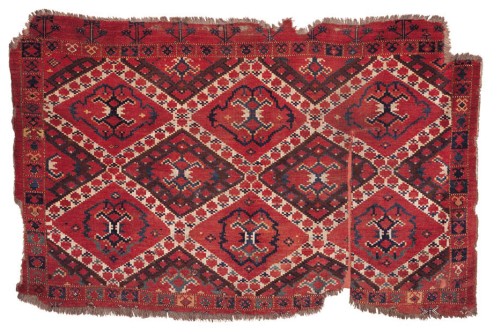
or even this Uzbek weaving.
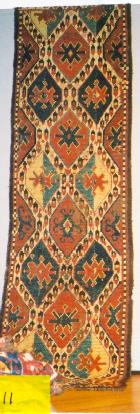
Dave
The Lattice
Greetings All
Perhaps this green lattice evident on the face of the
palas,
is an analog to other Turkmen pile woven designs such as the one on
the Beshir bagface below,
or the following,
or even this Uzbek
weaving.
Dave
Lattice
All
The above mentioned lattice.
Dave
Closer still...
Greetings Everyone
Find below an image of an Ersari mafrash from my
collection with the palas design rendered in pile. There's that green
again.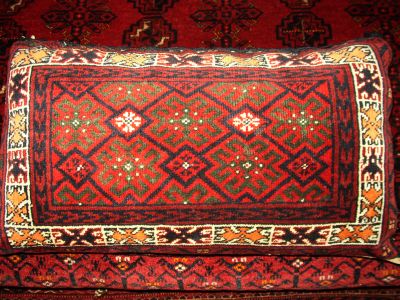
While
on the lattice subject, let's not forget the following images from 1420 and 1429
miniatures in von Bode's "Antique Rugs From The Near East" (pg.85) which is
accompanied by the following statements
"then regular repetition of
certain definite ornamental forms by the most diverse book illuminators permits
us satisfactory conclusions regarding their actual decorative stock-in-trade.
According to these reproductions the field appears to have been filled with
either with a simple scale-pattern or latticework, or else with a continuous and
usually rather loose plaited design, in which stars, rosettes, hexagons or other
incidental motives were interspersed".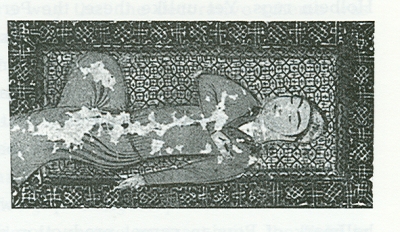
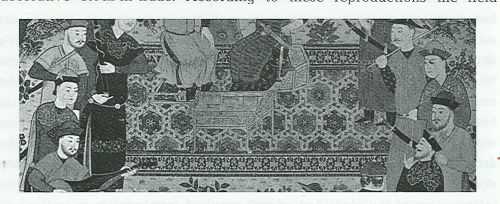
Dave
One More Time
Greetings
Just another example.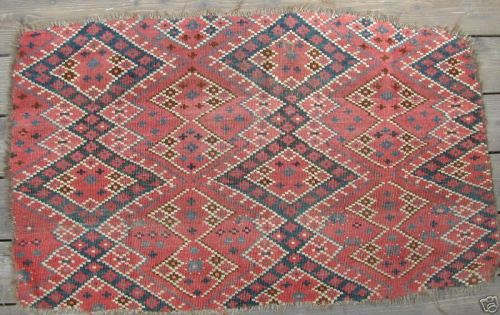
Dave
lattice subject
Bonjour à tous
The lattice design is a complexe subject that would
need an entire salon.
Amicalement
Louis
Hi Dave
Tracing design or motif history is a slippery slope. The more
complex and specific a design is, the better the chances are of solving the
riddles. Conversely, it's probably impossible to trace very simple motifs
without substantial information beyond the times that the designs can be found
in various places.
The straight line segment or pair of intersecting
lines (a cross) are probably beyond the range of things whose history can be
traced. They almost certainly had multiple origins; nobody had to carry them
from one culture to another.
Lattices are more complicated than lines or
crosses, but not by much. I'm sure that they, too, had multiple origins, since
there's probably no culture on the planet that didn't have something like them
in their design repertoires. For that reason, I think it's a mistake to try to
connect the many lattice examples that are around.
It is kind of fun,
though.
Regards
Steve Price
Dear folks -
I think the point the Steve makes above is part of what
troubles me about a lot of the comparisons, arguments and seeming conclusions
being made here.
I think we need to be careful about how widely we make
such comparisons. At some level of generality nearly any design can be argued to
have some similarities with almost any other.
I'm not sure such
comparisons take us very far.
Regards,
R. John Howe
There's My Cue...
Louis, Steve, John, All
Yes, the lattice alone could constitute an
entire salon itself, it's significance proceeding as much from geometry and it's
relation to design in general as from the multiple types or manifestations, as
in the Herati designs and dragon carpets, Kurdish tribals, ect..
John,
you have said that you don't believe that such comparisons, as in the examples
posted in this thread,take us very far, and as yet I agree. But I hope to change
this.
Steve, you have stated that "it's probably impossible to trace very
simple motifs without substantial information beyond the times that the designs
can be found in various places". Once again I agree, but as with John above,
maybe I can alter this perception, in the least in regard to the examples we
have here, in which I believe the effects of proximity and the influences of
other textile patterns have come together in a regional style.
We seem to
have three basic patterns here, based upon the palas brocade, the ikat, and the
Mina Khani or Herati pattern, and I believe the relationships inherent in these
three designs, which closely parallel those revealed in the salon, can
contribute much to our understanding of Turkmen weaving in general.
I'll
put something together and try to get it up soon.
Dave
Concluding Remarks
Greetings All
Sorry to have taken so long, just busy of
late.
"For the integrity of the whole is mutilated, if thou cuttest off
anything whatever from the conjunction and the continuity either of the parts or
the causes".
Marcus Aurelius - The Meditations
I had stated in
my previous post that we seem to have three basic patterns represented by the
Ersari here, based upon the palas brocade, the ikat, and the Mina Khani or
Herati pattern. I believe the relationships inherent in these three designs,
which closely parallel those revealed in the salon, can contribute much to our
understanding of Turkmen weaving in general, for I believe that the effects of
proximity and the influences of these other textile patterns have come together
in a regional style, encompassing not only the three above mentioned classes of
Ersari weaving, but the Turkmen gul format in general.
It is important to
keep in mind a few basic principals inherent to the study of Turkestan and in
turn Turkmen weaving in general, as postulated by Kalter in his "Arts And Crafts
Of Turkestan".
1. Forms and ornaments which appeared in their
characteristic shape for the first time in the Timurid period have dominated the
traditions of the arts and crafts untill well into our century.(Kalter,
pg.39)
2. Items which can be proved to be older than 100 to 150 years are
extremely rare.(Kalter,pg.26)
3. Late medieval cultural traditions have
survived untill our own time. This makes the study of the recent cultures of
Turkestan so fertil, but at the same time so difficult; they can only be
understood from a historical point of view.(Kalter, pg.41)
In short, the
cultures of Turkestan have been static since the decay of the Mongol empires,
and it is possible that traditions such as the use of the Palas as a floor
covering and the influences of ikat weaving upon that of pile, may date to this
early period. There is practically no physical evidence, so that which can be
learned must proceed from correlation.
Brocade Based Patterns
Pile
woven examples of Palas brocade patterns seem to be straight forward enough, and
there seems to be a high correlation of design elements between the two groups.
Given the propensity for weavers to imitate tile work and engraved patterns, and
in turn for there to be numerous examples of tile and stone engraving imitating
carpet, it seems matter of course that pile floor coverings would imitate the
patterns of brocaded floor coverings as in the palas. That the palas repesents,
as Mr.Slattery contended in the most important "More Palas Pictures" thread of this salon, "clearly the most
basic type of floor covering to be found in this part of Central Asia" , and in
keeping with Kalter's principal #3 above, which would assert that the palas has
been as such since the late middle ages, further the plausibility that Turkmen
gul patterns and symmetry mimic brocaded Palas patterns and
symmetry.

Ikat Weave
It seems that a large number of Turkmen weavings
fall into this class, weavings possessed of patterns and designs which mimic the
patterns of ikat cloth, which itself is so important in this part of the world
and which has an extensive history of production in the Turkmen regions.The size
of this class of weavings speaks much of the importance of ikat, so esteemed and
imitated.
The similareties between the two, Ikat and pilework, are many,
but this discussion will center upon two characteristics or qualities of
construction and design, those of warp based design and the symmetry of
design.
It is entirely of coincidence that both the ikat and the pile
woven rug should both be of a warp based design structure, in which the design
is applied to the warps by way of dying sections of the warp in ikat, and by
attaching dyed knots of wool to the warp strands in the pile weave. However, it
is no coincidence that the patterns of the two fabrics share the same symmetry,
for this characteristic of being a warp based design both expedites the
borrowing of designs and symmetry and encourage the transaction, by way of
simplifying of the process by which patterns can be transcribed from one medium
to the other.
The symmetry of design, between ikat and the pile woven gul
format, is perhaps even better demonstrated by considering the process by which
the design is layed out upon the ikat warps by a technique of halving and
folding the warps upon themselves in order to form a repeating pattern. The
following simple demonstration will clairify this process.
Take an 8 x 11
sheet of standard paper and folds it in half along it's length. Then fold it
again lengthwise. Take the resulting narrow strip and fold it in half along its
narrowest boundry, then fold the resulting rectangle again, across it's shortest
dimension. Now crease the paper heavily upon the edges, and then unfold it to
reveal the perfectly symmetrical grid. The grid which shares the symmetry of the
Turkmen gul format design. Simplicity in itself, this temporal exercise in
design symmetry.
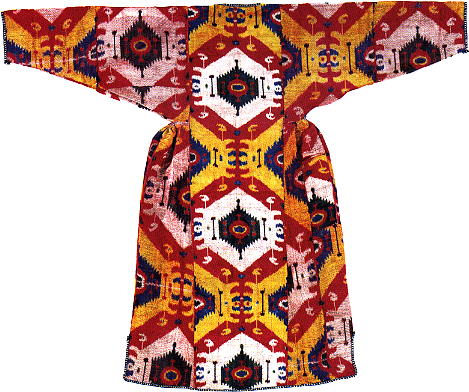
I will return to complete this discussion
shortly.
Dave
P.S. Does this belong here with the other ikat
patterns?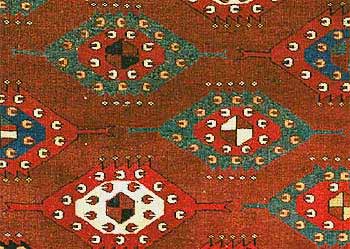
Completion
Greetings All
Find below the final installment of my
conclusion.
The Herati Pattern
The pervasiveness of the Herati or
Herati based patterns speaks of the Turkmen region's proximity to the city of
Herat. As Wilhelm von Bode states in his "Antique Carpets of the Near East",
"the capital of Khorassan, accredited as a carpet center, had great significance
under the Timurids as a cultural focus untill about 1500, but then lost it's
political importance in favor of Tabriz", and as is so often the fashion,
weaving areas adjacent to important production centers adopt the patterns of
said products. Such seems the case with these Ersari, although other weaving
centers, producing any of the myriad interpretations of this Herati lattice
based pattern could possibly be the source.


We now seem to have come
full circle, for here we are speaking of the pervasive nature of the lattice, as
a source of so much inspiration in carpet designs of the classical period and of
uncounted rural variations. Remembering Bode's assertion from above regarding
Timurid carpets " the field appears to have been filled with either with a
simple scale-pattern or latticework, or else with a continuous and usually
rather loose plaited design, in which stars, rosettes, hexagons or other
incidental motives were interspersed", it seems plausible to conclude that the
Herati pattern is of Mongol origin. Bode continued as above with the following ;
"Now and then there is originated in this way one of those cross and
star effects with multiple modifications that seem so akin to the Persian tile
floors, or in other cases,again, we will be reminded of the octagon systems of
the Turkmen and Anatolian rugs".
As such, the lattice and the
interspersed elements are of an inverse relation to each other. Where we see a
field of octagons, we find a lattice work in the negative space, and of the
lattice field we see opportunity for octagons, stars, turkmen guls, ect., in the
negative. These patterns are intimately related.
In short, it seems that
the effects of proximity and the influences of other textile patterns have come
together in a regional style.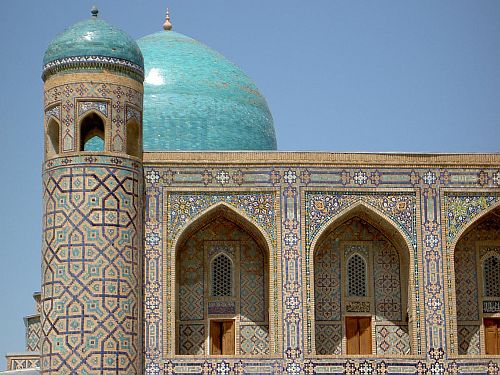
Dave
Particular Ornamental Style
Greetings Everyone
On page 195 of "Art Of Islam", Carel J. Du Ry makes
an interesting comment regarding a particilar ornamental style. "What one might
describe as ceramic marquetry was a decorative feature particularlly esteemed by
the Mongols".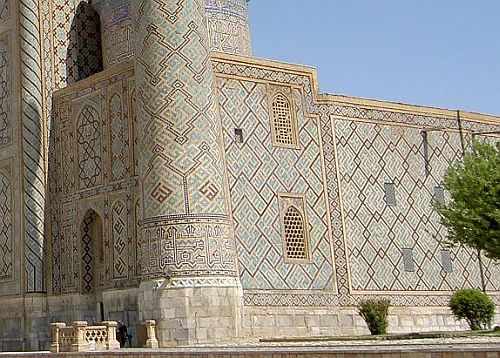
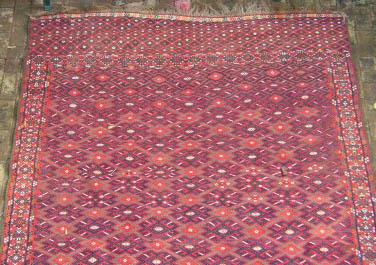
Dave
More Analogs
Greetings All
Find below a doorway from thr Great Mosque of Cordova,
circa 785 A.D. in Cordova, Spain,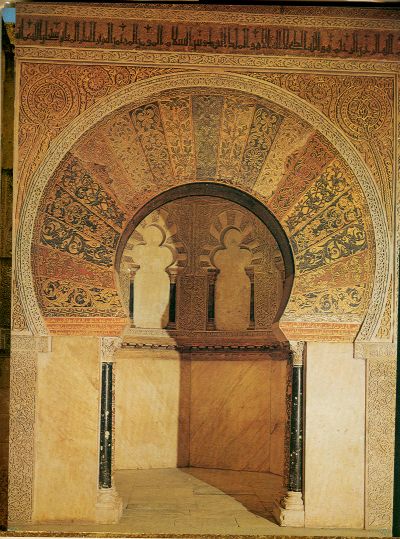
compared to a doorway from
Samarkand, 13th -15th cent.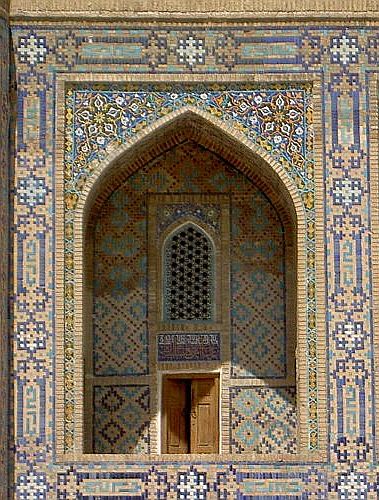
Notice these floral devices
on either side of the doorway. It has been suggested that the first, from
Cordova, could be of the pomegranat such as found in the image
below.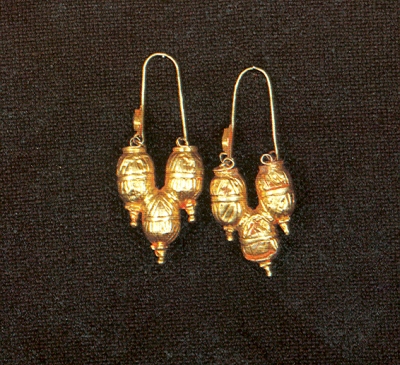
As kalter states, and as discussed on the Middle Amu
Darya thread here on Turkotek
"Earrings composed of three spheroids,
like ours from the Ferghana valley, have been shown to go back to the jewlery of
ancient South Arabia and pre-islamic Iran and had spread throught the islamic
world even in the age of the first caliphs".
Dave
Woven Screens
Greetings Again
I found this image in Kalters "Arts and Crafts of
Turkestan" of a Sart (urban resident of Turkestan) kitchen.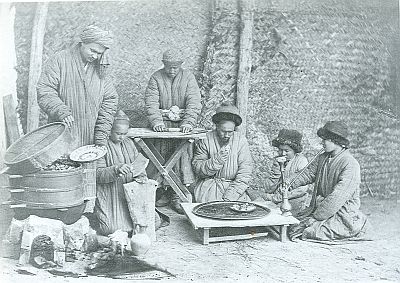
I was struck by these
large woven screens in the background. I found something quite similar on Marla
Mallett's website as below.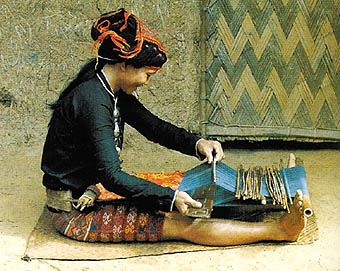
Could there be some connection?
Dave
Herati
Greetings All
Just two images of a mosque in Khiva from Katharina's
album, decorated with this exquisite tile work and reminescent of these finely
detailed Herati patterns.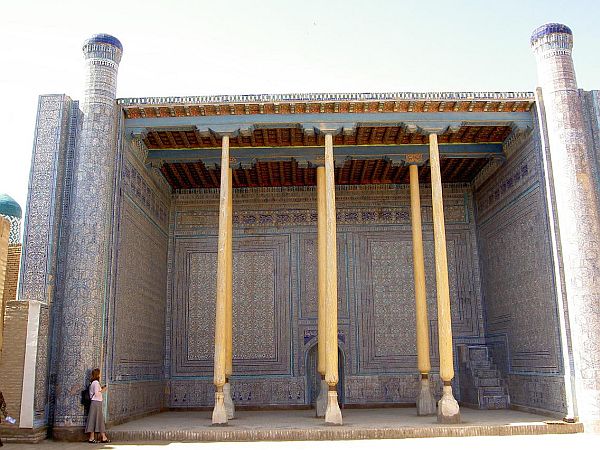
Link to full size image.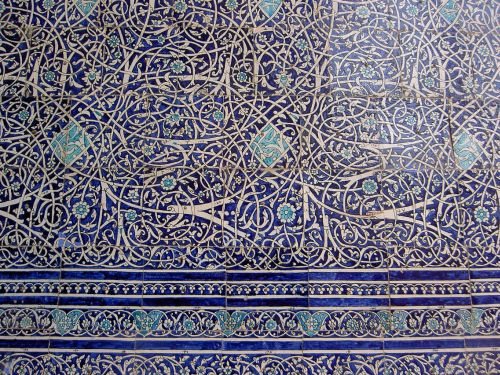
Link to full size image.
Dave